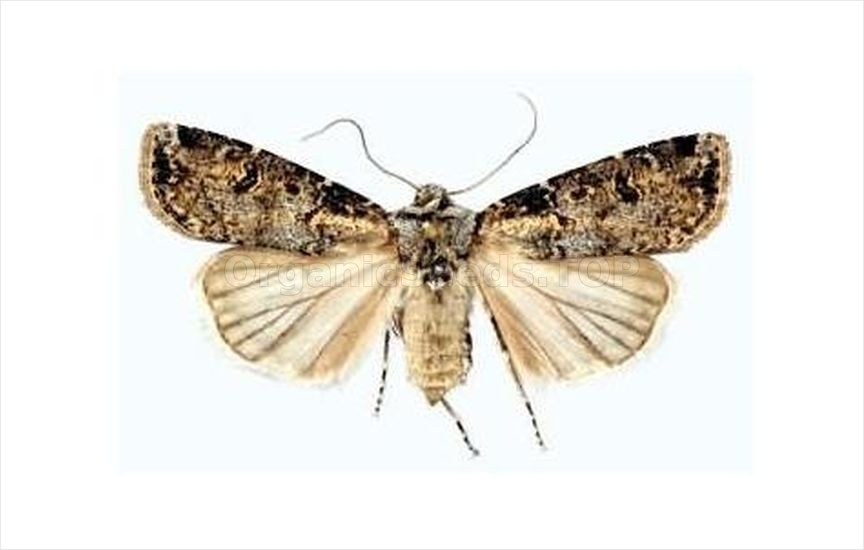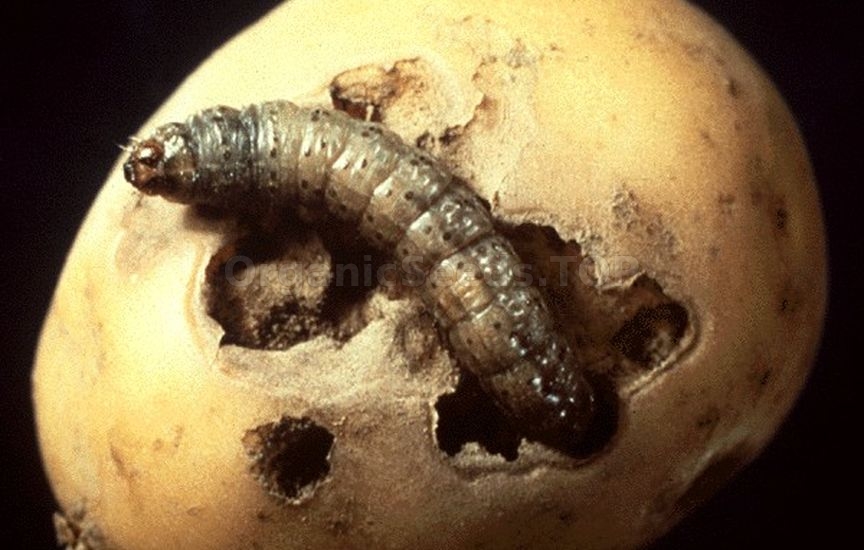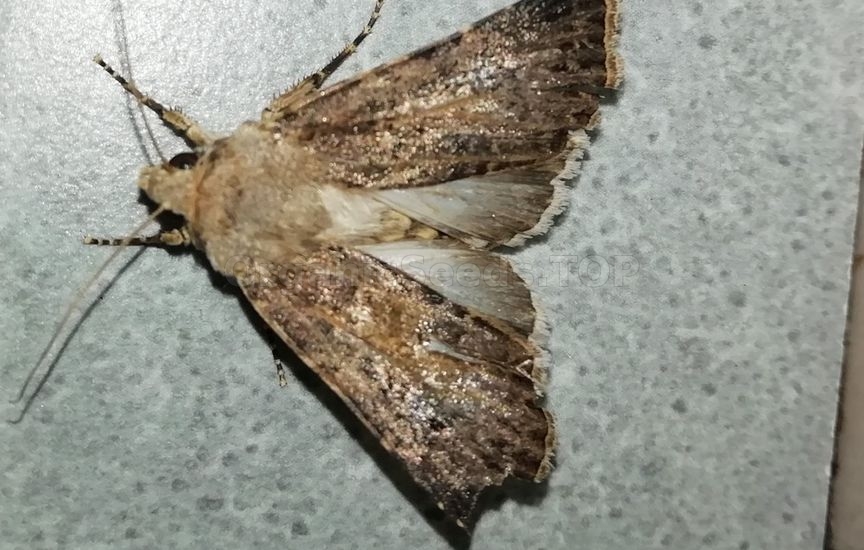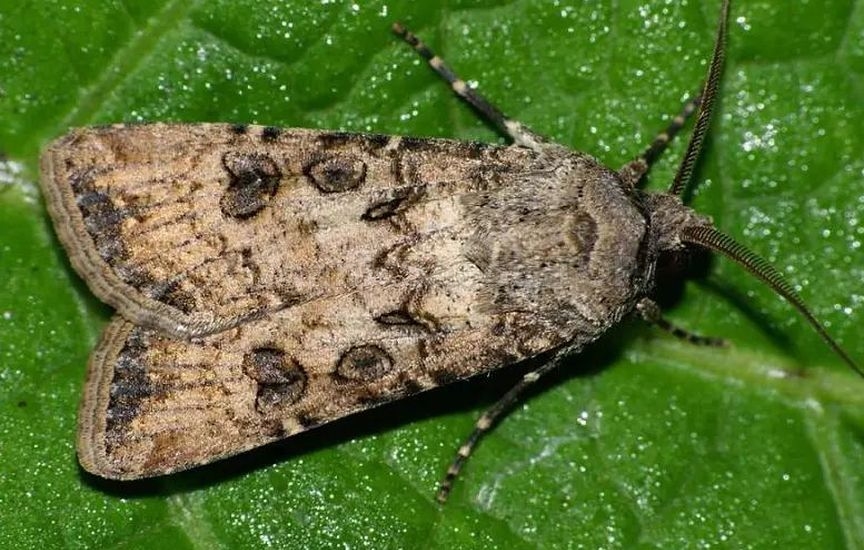Turnip moth - «Scotia segetum» |
 The turnip moth - is a pest of vegetable and melon crops, cereals, corn, cotton, sunflower, hemp, tobacco, sesame, grapes, tea bushes, seedlings and saplings of various tree species. Development is complete. Reproduction is bisexual. Caterpillars of older generations overwinter. In the north of the range one generation develops, in the south - three or four. Belongs to the economic group of gnawing cutworms. MorphologyImago
A butterfly with a wingspan of 30-46 mm. The forewings are gray with an admixture of brown scales, less often pure gray. The head and chest are covered with hairs mixed with scales. The drawing is clear. The first transverse line looks like a double narrow light stripe, reaching only half the width of the wings. The second transverse line is slightly slanted outward. It is light, double, thinly bordered with black. The wedge-shaped spot is short, gray, bordered with black, barely reaching the round spot. A round spot of regular or oval shape, light, thinly outlined in black. The lesion between the round and kidney spots is not noticeable, but the middle shadow is often quite clearly expressed. A kidney-shaped spot of regular shape, a large, dark gray space in the center, surrounded by a light and clearly defined black border. The third transverse line begins under the kidney spot, then doubles, bends outward and shifts. The marginal line is thin, light, weakly wriggling, bordered on the inside by dark.  The terminal line is black and looks like unfused strokes. The fringe is gray. The hind wings are dull white or slightly darkened, especially along the outer edge and along the veins. The terminal stripe is especially pronounced. The fringe of the hind wings is white. The underside is light, almost pure white, with an admixture of dark scales. Sexual dimorphism Individuals of different sexes differ in the structure of their genital organs. Female. The color of the wings is darker than that of males. The antennae are bristly. Male. The color of the wings is lighter than that of females. The antennae are 2/3 longer than the body. Egg The egg is white, with 45-48 radial ribs, diameter - 0.5-0.6 mm. Larva Larva (caterpillar) up to 40-50 mm long. The color of the cover is earthy-gray with a greasy sheen. There are black stripes along the back and sides, the skin is finely granulated, the head is reddish. The scutellum located in the spiracles is twice as large as the other scutellum. Pupa Length - 16-20 mm. The color of the integument is reddish-brown. There are two sharp projections on the cremaster, and one blunt hill on each side. Base of 5th-7th abdominal segments on the dorsal side with 1-2 rows of large pits. DevelopmentImago
The beginning of the summer of butterflies of the first summer generation is observed in May - June, in the southern regions of the range - from the end of April. Mass flight begins at an air temperature of 16-17°C and lasts up to 20 days. The lifespan of the moth moth ranges from 5 to 25 days, with a maximum of 35-40 days. During the day, butterflies hide under plant debris. To mature the eggs, butterflies undergo additional feeding on flowering vegetation for 4-12 days. Butterflies feed in the evening, finishing feeding before 9-10 pm. By the evening it weakens, and some intensification is observed after two o'clock in the morning. Second generation butterflies fly from mid-July to mid-September. They lay eggs in the first half of August and concentrate on fallow fields and low-growing crops.  Mating period In the evening (until 21-22 o'clock) and after two o'clock in the morning, intense flight, mating and laying of eggs by butterflies is observed. One female can lay from 470 to 2200 eggs. To do this, they choose light, loose, well-cultivated soils with sparse vegetation. Females lay eggs scattered one at a time or in small clusters on the underside of leaf blades or cuttings of low-growing weeds, on dry plant debris or on the ground. Egg Embryonic development at a temperature of 29-30°C lasts 3-5 days. At +10-12°C - up to 24 days. For the development of eggs, a sum of effective temperatures of 60-65°C is required. The lower threshold for embryo development is + 10°C, the upper threshold is + 36°C. The optimal temperature for egg development is + 18-27°C. At high soil and air temperatures, the eggs die. Larva The larva (caterpillar) goes through six instars. Optimal conditions for the development of the first age: temperature + 16-30°C, relative air humidity 75-100%. For II-VI centuries: + 18-25 ° C and 70-95%. The development of the caterpillar lasts 24-36 days, but with a decrease in temperature and precipitation it can be delayed up to 90-100 days. The last duration of development of caterpillars is typical for the northern part of the range. Caterpillars feed in the evening and at night. During the day, they hide on the underside of leaves adjacent to the ground or in the surface layer of soil. Caterpillars of early instars feed mainly on weeds: quinoa, mallow, bindweed, and thistle. They gnaw leaves from the underside without affecting the epidermis of the upper part. They can damage sown seeds of corn and cotton, gnaw through seedlings of various crops in the root collar area, eat away the root collar of sugar beets and damage cotton cotyledons. Starting from the third generation, the caterpillars move to various vegetable crops, sugar beets, millet, corn, cotton, and melons. At this time, they are already eating holes in the leaves, and at an older age they completely eat the leaves, leaving only the central vein. Caterpillars of the second or subsequent summer generations feed until the beginning of October, in years with warm autumn - until mid-October and, having reached the V-VI generation, go into the soil for wintering to a depth of 10-25 cm. Wintering caterpillars tolerate temperatures down to -11°C, and at low humidity - up to -18°C. Younger caterpillars can withstand temperatures down to -5°C. They remain in the surface layer of soil and die at the beginning of winter. In spring, the activation of caterpillars and their rise to the upper layers of the soil is observed when the soil at a depth of 20 cm warms up to + 10°C. Pupa Overwintered caterpillars rise to the upper layers of the soil, where they pupate in a cave. The pupa develops in 25-35 days. The caterpillar of the older generation, having finished feeding, makes an earthen cave in the soil at a depth of 1-6 cm and turns into a nymph. After 2-10 days, the nymph transforms into a pupa. Summer pupae develop in 11-14 days. The nymphal phase is the most xerophilic, and high humidity affects it negatively.  Abiotic factorsThe duration of the development cycle of the summer generation of the winter armyworm is 50-70 days. The sum of effective temperatures required for the successful development of one generation ranges from 550 to 750 °C.
The turnip moth - is a broad polyphagous species. Caterpillars of different ages cause damage. Damages winter cereals, millet, corn, potatoes, sugar beets, cotton, melons, vegetables, hemp, sunflower, rapeseed, sesame, asparagus, grapes, coffee trees, tea bushes, seedlings and saplings of tree species. In total, 150 species from 36 families are included in the food plants of the winter armyworm. The harmfulness of the winter armyworm is very high. One first generation caterpillar can destroy 10-15 sugar beet plants in one night.
You may need:«Turnip moth» trapPheromone trapsGlue trap (single adhesive cardboard) 205x125 mm |
|
|
